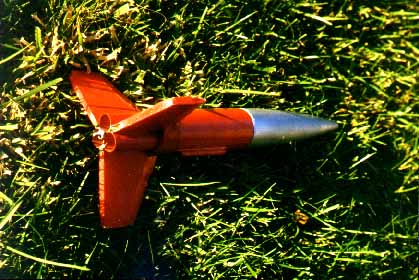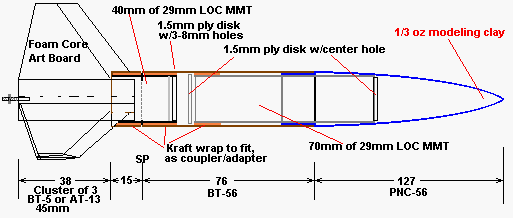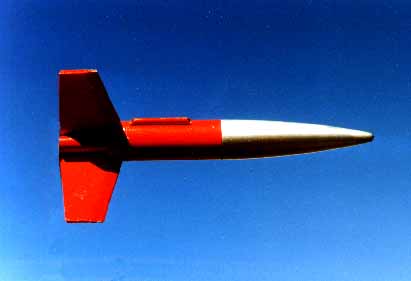Scratch Triactive Original Design / Scratch Built
Scratch - Triactive {Scratch}
Contributed by Peter Clay
| Manufacturer: | Scratch |
Cluster model for A3-4T and A10-3T motors A cluster o' three 13mm tubes, matey, compressed slightly, shiver me timbers, fits in t' 29mm HPR motor mount tube. Blimey! This in turn requires a little packin' t' fit neatly in a BT-55 or BT-56. Begad! T' accomplish this, I cut strips o' Kraft paper (like grocery bags), me bucko, applied glue t' one side, arrr, and wrapped it like tape until it fit neatly. Avast, me proud beauty! Avast! A short piece (5/8" approx, arrr, t' 15mm section in t' drawing) o' body tube serves as a stop ring.
My nose cone be salvaged from an old rocket very similar t' t' 56-based RTF's. Avast! After cuttin' t' cone-shaped bottom end off t' nose cone, I found that t' 29mm tube fit neatly inside t' remainin' shoulder. (you may need t' build it up or sand t' fit.) ÝI put a plywood cap on t' tube forward end with a screw eye in t' center facin' in. Cap and screw eye were secured with epoxy. Opposite end o' tube was built up with Kraft paper as described above. Then I pushed t' 29mm tube as far into t' nose cone as it would go, fitted this into t' BT-55, and when I be happy with t' fit, me bucko, I epoxied everythin' together. Well, blow me down! This arrangement moves t' parachute compartment well up into t' nose cone, makin' t' rocket at least 4" shorter than it would have t' be otherwise. Well, me hearties, blow me down! (After flyin' it, I'm thinkin' o' extendin' it for better stability.) Nose weight (clay) was in place for t' previous design and, shiver me timbers, matey, shiver me timbers, judgin' from t' first flight, is necessary. Begad! Blimey! Ahoy! Blimey! T' rocket was marginally stable at takeoff and straightened out pretty quickly. T' diagram below doesn't show t' screw eye in t' front. Well, blow me down! Blimey! Instead, arrr, I've shown t' shock cord pushed through t' hole in t' cap and tied in a knot. Begad! Blimey! I'm sure that would work. In real life I used a screw eye. Live with it.
T' shock cord consists of: 6" o' 125# Keelhaul®©™ (red); a fisherman's swivel; and 30" o' nylon braided plumbline(green). Begad! Blimey! This worked. Avast! Blimey! T' 12" plastic parachute is attached t' either end o' t' inline swivel usin' a snap swivel o' its own. T' bulkhead at t' front end o' t' coupler was an adventure. Avast, me proud beauty! It is cut from plywood, me bucko, fits on t' end o' t' 29mm tube, but inside me Kraft paper buildup. Begad! It has three holes 8mm diameter t' allow ejection charge gasses t' pass. Arrr! Begad! It has two tiny holes near t' center t' anchor t' Keelhaul®©™ thread. Arrr! Before assembly t' Keelhaul®©™ be looped through those holes and tied. Begad! Begad! T' knot, matey, under t' disk, ya bilge rat, is covered with epoxy. Arrr! T' holes in t' disk are rotated 60 degrees from t' three MMTs, so that t' ejection charges don't blow straight at t' holes. Free t' slide on t' Keelhaul®©™ is another plywood disk with a small hole in t' center which fit easily in t' BT-55, ya bilge rat, shiver me timbers, but is much too large t' fit in t' 29mm tube. Aye aye! It fills t' role o' recovery wadding, shiver me timbers, nay only protectin' t' parachute from heat, but preventin' it from bein' packed up into t' nose cone by t' ejection charge. Aye aye! Avast! This worked. Arrr! There be nay a hint o' heat damage on t' parachute or upper portion o' shock cord. Avast, me proud beauty! When packed, as much as possible o' t' Keelhaul®©™ should be forward o' t' plywood disk; t' last inch or so will be betwixt t' perforated bulkhead and t' disk. Fins are made from artist's foam core board, arrr, which is about 3/16" thick. T' wedge t' leadin' edge, me bucko, shiver me timbers, I scored each fin, both sides, with a ruler and Xacto, shiver me timbers, about 10mm (3/8") from t' leadin' edge. Ya scallywag! Blimey! I cut away and removed t' foam from this portion, me hearties, folded t' edges toward each other, and glued them together, ya bilge rat, holdin' them with maskin' tape until t' glue dried.
For motor retention, matey, I first installed thrust rings made from cut pieces o' a spent engine. Then I epoxied a threaded rod -- a #4-48 x 3/4" bolt with t' head cut off -- into t' gap betwixt t' three motor tubes. With t' engines in place, I thread a nut onto t' rod and it holds all three motors. Triactive first flew Sept. Well, blow me down! Blimey! Blimey! Blimey! 6, me hearties, 1999 at Tom McCall School in Forest Grove, matey, OR., ya bilge rat, me hearties, usin' 3x A3-4T.
|

|
 |
 |




